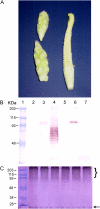Bs1, a new chimeric gene formed by retrotransposon-mediated exon shuffling in maize
- PMID: 20488894
- PMCID: PMC2899935
- DOI: 10.1104/pp.110.157420
Bs1, a new chimeric gene formed by retrotransposon-mediated exon shuffling in maize
Abstract
Transposons are major components of all eukaryotic genomes. Although traditionally regarded as causes of detrimental mutations, recent evidence suggests that transposons may play a role in host gene diversification and evolution. For example, host gene transduction by retroelements has been suggested to be both common and to have the potential to create new chimeric genes by the shuffling of existing sequences. We have previously shown that the maize (Zea mays subsp. mays) retrotransposon Bs1 has transduced sequences from three different host genes. Here, we provide evidence that these transduction events led to the generation of a chimeric new gene that is both transcribed and translated. Expression of Bs1 is tightly controlled and occurs during a narrow developmental window in early ear development. Although all Bs1-associated transduction events took place before Zea speciation, a full uninterrupted open reading frame encoding the BS1 protein may have arisen in domesticated maize or in the diverse populations of its progenitor Z. mays subsp. parviglumis. We discuss potential functions based on domain conservation and evidence for functional constraints between the transduced sequences and their host gene counterparts.
Figures




Similar articles
-
A novel hybrid open reading frame formed by multiple cellular gene transductions by a plant long terminal repeat retroelement.J Biol Chem. 2001 Nov 9;276(45):41963-8. doi: 10.1074/jbc.M105850200. Epub 2001 Sep 11. J Biol Chem. 2001. PMID: 11553621
-
Integration and nonrandom mutation of a plasma membrane proton ATPase gene fragment within the Bs1 retroelement of maize.Plant Cell. 1994 Aug;6(8):1177-86. doi: 10.1105/tpc.6.8.1177. Plant Cell. 1994. PMID: 7919987 Free PMC article.
-
Capturing of host DNA by a plant retroelement: Bs1 encodes plasma membrane H(+)-ATPase domains.Plant Mol Biol. 1994 May;25(2):137-40. doi: 10.1007/BF00023232. Plant Mol Biol. 1994. PMID: 8018864
-
Structure and coding properties of Bs1, a maize retrovirus-like transposon.Proc Natl Acad Sci U S A. 1989 Aug;86(16):6235-9. doi: 10.1073/pnas.86.16.6235. Proc Natl Acad Sci U S A. 1989. PMID: 2474829 Free PMC article.
-
Post-transcriptional and translational regulation of plant gene expression by transposons.Curr Opin Plant Biol. 2023 Oct;75:102438. doi: 10.1016/j.pbi.2023.102438. Epub 2023 Aug 22. Curr Opin Plant Biol. 2023. PMID: 37619514 Review.
Cited by
-
Transcriptome-wide identification and systematic analysis of the Retrotransposon genes and their roles in ginsenoside biosynthesis in Panax ginseng.BMC Plant Biol. 2025 Jul 3;25(1):847. doi: 10.1186/s12870-025-06776-4. BMC Plant Biol. 2025. PMID: 40610882 Free PMC article.
-
Grande retrotransposons contain an accessory gene in the unusually long 3'-internal region that encodes a nuclear protein transcribed from its own promoter.Plant Mol Biol. 2013 Apr;81(6):541-51. doi: 10.1007/s11103-013-0019-2. Epub 2013 Feb 20. Plant Mol Biol. 2013. PMID: 23423698
-
Evolutionary history of exon shuffling.Genetica. 2012 Jun;140(4-6):249-57. doi: 10.1007/s10709-012-9676-3. Epub 2012 Sep 5. Genetica. 2012. PMID: 22948334
-
Androgenic-Induced Transposable Elements Dependent Sequence Variation in Barley.Int J Mol Sci. 2021 Jun 24;22(13):6783. doi: 10.3390/ijms22136783. Int J Mol Sci. 2021. PMID: 34202586 Free PMC article.
-
Origin of a novel protein-coding gene family with similar signal sequence in Schistosoma japonicum.BMC Genomics. 2012 Jun 20;13:260. doi: 10.1186/1471-2164-13-260. BMC Genomics. 2012. PMID: 22716200 Free PMC article.
References
-
- Arabidopsis Genome Initiative (2000) Analysis of the genome sequence of the flowering plant Arabidopsis thaliana. Nature 408: 796–815 - PubMed
-
- Banik M, Garrett TPJ, Fincher GB. (1996) Molecular cloning of cDNAs encoding 1,4-β-xylan endohydrolases from the aleurone layer of germinated barley (Hordeum vulgare). Plant Mol Biol 31: 1163–1172 - PubMed
-
- Bennetzen JL. (2005) Transposable elements, gene creation and genome rearrangement in flowering plants. Curr Opin Genet Dev 15: 621–627 - PubMed
-
- Bureau TE, White SE, Wessler SR. (1994) Transduction of a cellular gene by a plant retroelement. Cell 77: 479–480 - PubMed
Publication types
MeSH terms
Substances
LinkOut - more resources
Full Text Sources

